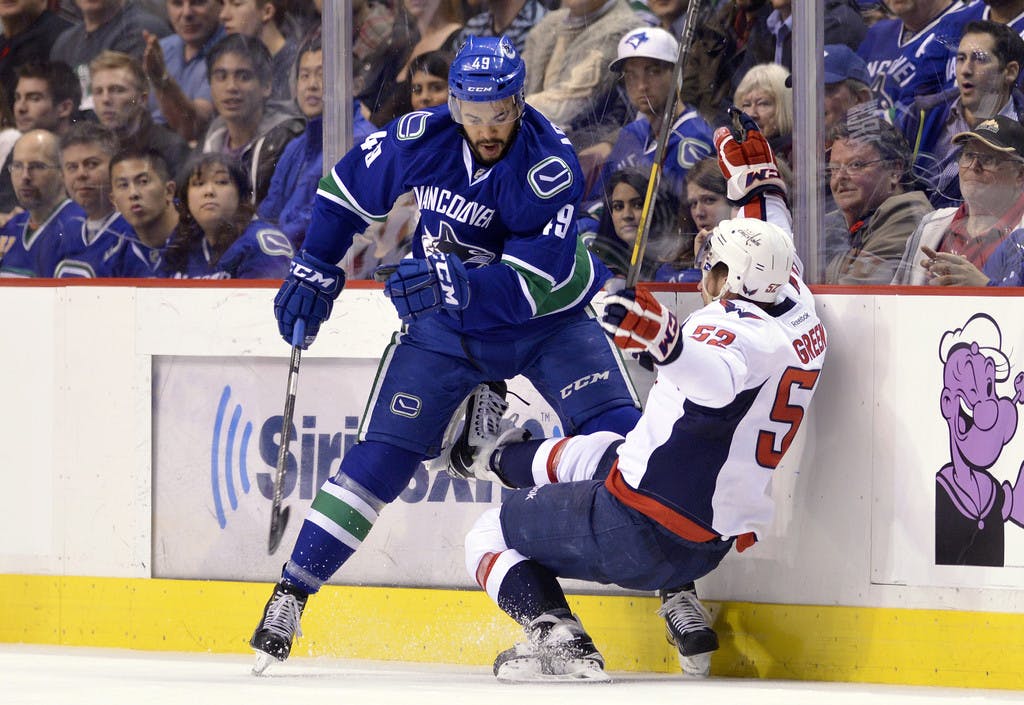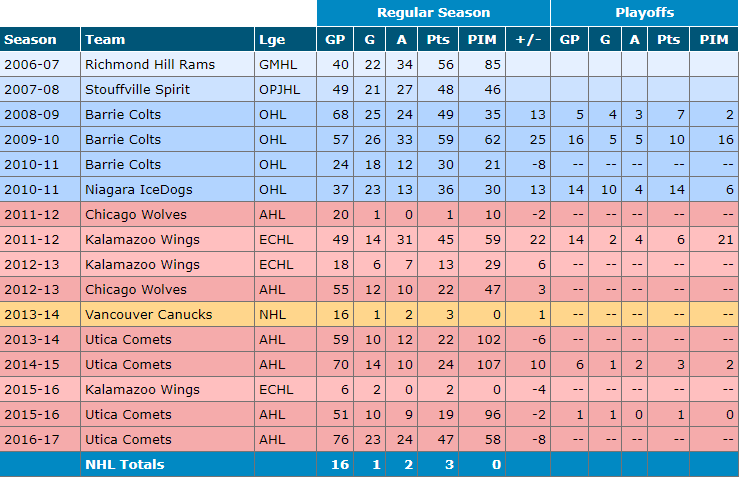Is Darren Archibald A Viable NHL Option?

By Jeremy Davis
6 years agoThe promotion of Travis Green as the new coach of the Vancouver Canucks is sure to change a few things about the way the Canucks play next season. Green’s style is noticeably distinct from his predecessor’s: he demands a lot from his players, be they rookies or veterans, and in return, those that earn his favour are willing to run through the end boards for him.
Green prefers his teams to play with speed, and to attack, but he also likes them to play with some grit. There aren’t a whole lot of players on the team that fit that bill right now, and Green certainly won’t be forcing unfit options into the lineup just to meet a grit quotient. For some players that are teetering on the edge however, playing to Green’s preferences may be a underrated advantage.
PTO players Scottie Upshall and Ryan White checked some of those boxes, but the former is heading back to the St. Louis Blues and the latter is currently out with a concussion. Besides that, after spending four seasons as the coach of the Utica Comets, Green may want to bring someone in with whom he is more familiar. That could be Jake Virtanen, who’s made a very strong case, but it could also be the only player left in training camp on an AHL deal: Darren Archibald.
Archibald already has a storied history with the Canucks. He was signed as a CHL free agent by Mike Gillis back in December of 2010, playing out his Entry Level deal between the OHL, ECHL and AHL. Re-signed to a two-way deal prior to the 2013-14 season, he got a cup of coffee in the NHL that year, spending 16 games with the John Tortorella coached Canucks. The team re-upped him for the 2014-15, but he hasn’t seen another game of regular season NHL action. Instead, he’s stayed within the Comets organization, signing AHL contracts and splitting time between Utica and Kalamazoo of the ECHL.

Source: HockeyDB
Reliably a 25-point pace guy at the minor league level, Archibald’s offence exploded last season, as he led the Comets in both goals (23) and points (47). He edged out Curtis Valk and Alex Grenier only narrowly, but had a markedly lower estimated average 5-on-5 ice time than the other two did, and considerably less power play time, though he did establish himself on the top unit in the second half of the season.
Archibald’s average ice time measured a little lower because Travis Green deployed him as a jack-of-all-trades. He got plenty of time on Utica’s top line, but also spent many games on the second, third, or fourth lines, depending on how healthy the roster was, and how well everyone else was playing. He made appearances with everyone from Cole Cassels to Wacey Hamilton to Phil DeSimone, though unsurprisingly it was with Valk and Grenier (the two players he ended up sharing the ice the most with) that he had the most success. The trio were, at one point, the AHL’s hottest line.
Failed to load video.
Finishing first in scoring on an admittedly inept offensive team is nice, but it’s hardly an indication on its own that Archibald can survive at the NHL level. Don’t forget though, as mentioned earlier, that he’s already been there before. His three points in 16 games in 2013-14 won’t jump off the page, but they certainly get better with the context of deployment.
Tortorella had a particular affinity for riding his stars and using his role players very sparingly. Archibald averaged 7:32 that season at 5-on-5, firmly in fourth line territory. Archibald’s three points came at a rate of 1.49 points per hour, just below Daniel Sedin, and above the likes of Ryan Kesler, David Booth, Jannik Hansen, and Alex Burrows. Had Archibald scored at that rate last season, he’d have been just shy of Henrik, and above Daniel, Markus Granlund, and even Brock Boeser.
Failed to load video.
Archibald’s Corsi-for percentage of 47.5% isn’t great either, but it is fairly standard for a fourth line player. It’s also better than the vast majority of bottom six players that the Canucks have acquired and slotted in since the last time Archibald played in the NHL, including Linden Vey, Derek Dorsett, Brandon McMillan, Adam Cracknell, Emerson Etem, Brandon Prust, Michael Chaput, Jayson Megna, Griffen Molino, Drew Shore, and Joseph Cramarossa. It’s also better than many of the Canucks’ middle or top six players in that time frame, including the likes of Bo Horvat, Brandon Sutter, and Sven Baertschi. Again, a sub-50% shot share isn’t ideal, but the Canucks could, and have been doing worse.
Archibald achieved these stats in just 120 minutes of 5-on-5 ice time at the NHL level, so there are some sample size warnings. His numbers could be worse, but they could just as easily be better. Over the course of four preseason games with Vancouver so far in 2017, he’s sporting a Corsi-for percentage of 56.5%, which is third among Canuck forwards with at least 10 5-on-5 minutes. It’s not likely that he’d continue at anywhere near that rate, but it is a testament to how strong a showing he’s had so far.
Last night he also showed that he can put the puck past an NHL goaltender. Well, past Mike Smith at least.
Archibald would be able to do the job that Derek Dorsett has supposedly been doing over the past few years. He can play with pace, he can kill penalties, and he can contribute a little bit of offence here and there. Perhaps more significantly, he hits opponents like an 18-wheeler.
Failed to load video.
Hits are an odd statistic, and the way they are counted rarely captures their value. Dorsett, for example, has thrown 328 hits as a Canuck, but far too few of them are actually useful. Finishing checks, as much as coaches love it, do precious little to help a team either score or not get scored on – which are the two most important aspects of hockey. Taking oneself out of position to land a meaningless hit on a player that has already passed the puck away adds nothing, and those are the types of hits we see too often from Dorsett. Not to mention his tendency to get into scuffles behind the play when the puck is being moved up ice.
When someone hits the way Archibald does though, there’s a tangible benefit. First, he gets to players faster, increasing the likelihood of the hit forcing a turnover. Second, he doesn’t rub his targets out against the boards, he obliterates them (cleanly, I might add), effectively taking opponents out of the play, or at least giving them something to think about the next time the puck in on their stick and Archibald is on the ice.
He’d also be able to do it for considerably cheaper. His last two NHL contracts were one-year pacts worth $660,000 and $600,000. Contrast that with the $2.65 million that Dorsett is making, and it seems like a no brainer. Unfortunately, the Canucks are saddled with Dorsett and his cap hit for two more seasons, meaning that they can’t truly benefit financially from swapping the two. Even if they buried Dorsett in the minors, they’d only save a couple hundred thousand.
With the injury to Brendan Gaunce, the demotion of Reid Boucher, and the uninspiring performances of a post-major-surgery Dorsett, I think that there’s some room here for Archibald to make a little noise. At 27-years of age, he’s far removed from prospect territory and I doubt they’d have to worry about the effect a few healthy scratches will have on him, making him an ideal extra forward. Archibald may have taken an unorthodox path to get here, but I do believe that he could indeed be a viable option on the NHL squad this season.
All NHL statistics courtesy of NaturalStatTrick.com
Recent articles from Jeremy Davis





